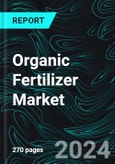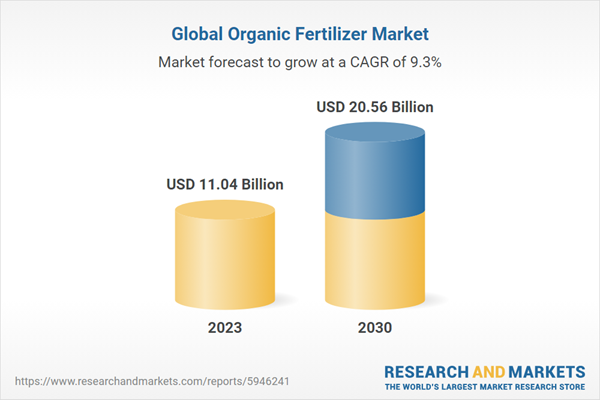Organic Fertilizer Market is predicted to experience a CAGR of 9.29% between 2024 and 2030
The upward thrust in attention surrounding environmental protection has substantially fueled the increase of the organic fertilizers market. As clients become more attuned to the ecological repercussions of agricultural practices, there may be a burgeoning demand for eco-friendly alternatives. A Science Direct article states that organic fertilizers are pivotal in sustainable agriculture and soil enhancement. They are available with no trouble at a considerable cost and are effortlessly relevant in fields. Using natural fertilizers leads to a 10-25% boom in crop yield. Derived from natural resources, natural fertilizers mitigate chemical runoff, soil erosion, and water pollutants.Moreover, organic farming has become increasingly popular as farmers opt for this method to cultivate healthier foods while lessening their environmental footprint. Organic fertilizers are critical in this agricultural approach, fueling the global market. According to the Research Institute of Organic Agriculture (FiBL), organic farming is practiced in 191 international locations, with over 76 million hectares of agricultural land managed organically with the aid of at least 3.7 million farmers.
Besides, government regulations to mitigate the negative consequences of chemical fertilizers on plants are driving the increasing demand for organic fertilizers. This trend is anticipated to propel the increase within the organic fertilizers market. For instance, the Indian authorities promote organic farming through schemes like Paramparagat Krishi Vikas Yojana (PKVY) and Mission Organic Value Chain Development in the North East Region (MOVCDNER) since 2015-16, imparting subsidies to farmers for both on-farm and off-farm organic inputs. Furthermore, the authorities plan to enlarge natural farming tasks to cover 7.5 lakh hectares alongside the Ganga basin and different rain-fed regions, transforming one crore farmers into natural farming practitioners by setting up 10,000 Bio-Input Resource Centers to deliver nearby farm livestock-based natural farming inputs constantly. This program targets to lessen reliance on chemical fertilizers. So, the value of the organic fertilizer market was about US$ 11.04 Billion in 2023.
The use of soil treatment is expected to play a significant role in the growth of the global organic fertilizer market
The global organic fertilizer market is fragmented by mode of application into Seed Treatment, Soil Treatment, and Root Dripping. Soil treatment is anticipated to contribute to the market by enhancing soil fitness, fertility, and sustainability. This aligns with the growing need for eco-friendly agricultural practices and the merchandising of organic farming worldwide.Fruits and vegetables are some of the essential components of the global organic fertilizer market
The organic fertilizer market is categorized by crop type into Cereals & Grains, Oilseeds & Pulses, Fruits & Vegetables, and Others. Fruits and vegetables are among the critical segments within the worldwide organic fertilizer market owing to heightened customer awareness of healthful dietary alternatives. Organic fertilizers improve soil fertility, resulting in higher yields and improved produce quality, meeting the developing demand for natural and nutritious fruits and greens worldwide.China might have a significant presence in the global organic fertilizer market
The global organic fertilizer market is categorized by country into five regions: North America (United States and Canada), Europe (France, Germany, Italy, Spain, United Kingdom, Belgium, Netherlands, and Turkey), Asia Pacific (China, Japan, India, Australia, South Korea, Thailand, Malaysia, Indonesia, and New Zealand), Latin America (Brazil, Mexico, and Argentina), and Middle East & Africa (South Africa, Saudi Arabia, and United Arab Emirates). China is among the considerable international organic fertilizer market players, driven by its widespread agricultural output and growing cognizance of sustainable farming methods. With a massive population and escalating environmental issues, China has prioritized natural agriculture, resulting in the sizable adoption of organic fertilizers. According to the Research Institute of Organic Agriculture FiBL, in 2023, organic farmland in China increased by nearly 320,000 hectares, marking a 13.1 percent boom. This trajectory is bolstered by governmental efforts to promote organic farming and environmental sustainability nationwide.Key Players
National Fertilizers, Madras Fertilizers, Seek Biotechnology Co. Ltd, Coromandel International, Nagarjuna Fertilizers and Chemicals Ltd, T Stanes& Company Limited, Novozymes, and Kribhco are noteworthy players in the global organic fertilizer market.Sources - Global Organic Fertilizer Market breakup in 3 viewpoints:
1. Plant Based2. Animal Based
3. Synthetic Based
Mode of application - Global Organic Fertilizer Market breakup in 3 viewpoints:
1. Seed Treatment2. Soil Treatment
3. Root Dripping
Product Type - Global Organic Fertilizer Market breakup in Microorganism & Organic Residues and further subdivided into 8 & 4 segments respectively:
A. Microorganism
1. Azospirillum2. Cyanobacteria
3. Phosphate-Solublizing Bacteria
4. Azolla
5. Aulosira
6. Rhizobium
7. Azotobacter
8. Others
B. Organic Residues
1. Farm Yard Manure2. Crop Residue
3. Green Manure
4. Other Products
Crop Type - Global Organic Fertilizer Market breakup in 4 viewpoints:
1. Cereals & Grains2. Oilseeds & Pulses
3. Fruits & Vegetables
4. Others
Form - Global Organic Fertilizer Market breakup in 2 viewpoints:
1. Dry2. Liquid
Country - Global Organic Fertilizer Market of 25 Countries covered in the report:
1. North America1.1 United States
1.2 Canada
2. Europe
2.1 France
2.2 Germany
2.3 Italy
2.4 Spain
2.5 United Kingdom
2.6 Belgium
2.7 Netherland
2.8 Turkey
3. Asia Pacific
3.1 China
3.2 Japan
3.3 India
3.4 South Korea
3.5 Thailand
3.6 Malaysia
3.7 Indonesia
3.8 Australia
3.9 New Zealand
4. Latin America
4.1 Brazil
4.2 Mexico
4.3 Argentina
5. Middle East & Africa
5.1 South Africa
5.2 Saudi Arabia
5.3 UAE
All the Key players have been covered from 3 Viewpoints:
- Overview
- Recent Development
- Revenue Analysis
Company Analysis:
1. National Fertilizers2. Madras Fertilizers
3. Seek Biotechnology Co. Ltd,
4. Coromandel International
5. Nagarujuna fertilizers and Chemicals Ltd,
6. T Stanes& Company Limited
7. Novozymes
8. Kribhco
Table of Contents
Companies Mentioned
- National Fertilizers
- Madras Fertilizers
- Seek Biotechnology Co. Ltd,
- Coromandel International
- Nagarujuna fertilizers and Chemicals Ltd,
- T Stanes& Company Limited
- Novozymes
- Kribhco
Methodology
In this report, for analyzing the future trends for the studied market during the forecast period, the publisher has incorporated rigorous statistical and econometric methods, further scrutinized by secondary, primary sources and by in-house experts, supported through their extensive data intelligence repository. The market is studied holistically from both demand and supply-side perspectives. This is carried out to analyze both end-user and producer behavior patterns, in the review period, which affects price, demand and consumption trends. As the study demands to analyze the long-term nature of the market, the identification of factors influencing the market is based on the fundamentality of the study market.
Through secondary and primary researches, which largely include interviews with industry participants, reliable statistics, and regional intelligence, are identified and are transformed to quantitative data through data extraction, and further applied for inferential purposes. The publisher's in-house industry experts play an instrumental role in designing analytic tools and models, tailored to the requirements of a particular industry segment. These analytical tools and models sanitize the data & statistics and enhance the accuracy of their recommendations and advice.
Primary Research
The primary purpose of this phase is to extract qualitative information regarding the market from the key industry leaders. The primary research efforts include reaching out to participants through mail, tele-conversations, referrals, professional networks, and face-to-face interactions. The publisher also established professional corporate relations with various companies that allow us greater flexibility for reaching out to industry participants and commentators for interviews and discussions, fulfilling the following functions:
- Validates and improves the data quality and strengthens research proceeds
- Further develop the analyst team’s market understanding and expertise
- Supplies authentic information about market size, share, growth, and forecast
The researcher's primary research interview and discussion panels are typically composed of the most experienced industry members. These participants include, however, are not limited to:
- Chief executives and VPs of leading corporations specific to the industry
- Product and sales managers or country heads; channel partners and top level distributors; banking, investment, and valuation experts
- Key opinion leaders (KOLs)
Secondary Research
The publisher refers to a broad array of industry sources for their secondary research, which typically includes, however, is not limited to:
- Company SEC filings, annual reports, company websites, broker & financial reports, and investor presentations for competitive scenario and shape of the industry
- Patent and regulatory databases for understanding of technical & legal developments
- Scientific and technical writings for product information and related preemptions
- Regional government and statistical databases for macro analysis
- Authentic new articles, webcasts, and other related releases for market evaluation
- Internal and external proprietary databases, key market indicators, and relevant press releases for market estimates and forecasts

LOADING...
Table Information
| Report Attribute | Details |
|---|---|
| No. of Pages | 270 |
| Published | March 2024 |
| Forecast Period | 2023 - 2030 |
| Estimated Market Value ( USD | $ 11.04 Billion |
| Forecasted Market Value ( USD | $ 20.56 Billion |
| Compound Annual Growth Rate | 9.2% |
| Regions Covered | Global |
| No. of Companies Mentioned | 8 |









